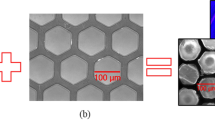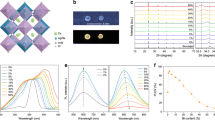Abstract
Medical X-ray imaging requires cost-effective and high-resolution flat-panel detectors for the energy range between 20 and 120 keV. Solution-processed photodetectors provide the opportunity to fabricate detectors with a large active area at low cost. Here, we present a disruptive approach that improves the resolution of such detectors by incorporating terbium-doped gadolinium oxysulfide scintillator particles into an organic photodetector matrix. The X-ray induced light emission from the scintillators is absorbed within hundreds of nanometres, which is negligible compared with the pixel size. Hence, optical crosstalk, a limiting factor in the resolution of scintillator-based X-ray detectors, is minimized. The concept is validated with a 256 × 256 pixel detector with a resolution of 4.75 lp mm−1 at a MTF = 0.2, significantly better than previous stacked scintillator-based flat-panel detectors. We achieved a resolution that proves the feasibility of solution-based detectors in medical applications. Time-resolved electrical characterization showed enhanced charge carrier mobility with increased scintillator filling, which is explained by morphological changes.
This is a preview of subscription content, access via your institution
Access options
Subscribe to this journal
Receive 12 print issues and online access
$209.00 per year
only $17.42 per issue
Buy this article
- Purchase on Springer Link
- Instant access to full article PDF
Prices may be subject to local taxes which are calculated during checkout




Similar content being viewed by others
Change history
13 November 2015
In the version of this Article originally published online, the following affiliation for the author Oier Bikondoa had not been included: Department of Physics, University of Warwick, Gibbet Hill Road, Coventry CV4 7AL, UK. This has now been added and the subsequent affiliation renumbered in all versions of the Article.
References
Spahn, M. Flat detectors and their clinical applications. Eur. Radiol. 15, 1934–1947 (2005).
Pacella, D. Energy-resolved X-ray detectors: the future of diagnostic imaging. Rep.Med. Imag. 8, 1–13 (2015).
Kabir, M. Z. et al. Direct conversion x-ray sensors: Sensitivity, DQE and MTF. IEEE Proc. Circ. Dev. Syst. 150, 258–266 (2003).
Zhao, W., Ristic, G. & Rowlands, J. A. X-ray imaging performance of structured cesium iodide scintillators. Med. Phys. 31, 2594–2605 (2004).
Pin, Y., Harmon, C. D., Doty, F. P. & Ohlhausen, J. A. Effect of humidity on scintillation performance in Na and Tl activated CsI crystals. IEEE Trans. Nucl. Sci. 61, 1024–1031 (2014).
Kasap, S. et al. Amorphous and polycrystalline photoconductors for direct conversion flat panel x-ray image sensors. Sensors 11, 5112–5157 (2011).
Kabir, M. Z. et al. Effect of repeated x-ray exposure on the resolution of amorphous selenium based x-ray imagers. Med. Phys. 37, 1339–1349 (2010).
Kasap, S. O. X-ray sensitivity of photoconductors: application to stabilized a-Se. J. Phys. D 33, 2853–2865 (2000).
Gelinck, G. H. et al. X-ray imager using solution processed organic transistor arrays and bulk heterojunction photodiodes on thin, flexible plastic substrate. Org. Electron. 14, 2602–2609 (2013).
Tedde, S. F. et al. Fully spray coated organic photodiodes. Nano Lett. 9, 980–983 (2009).
Krebs, F. C. et al. A round robin study of flexible large-area roll-to-roll processed polymer solar cell modules. Sol. Energy Mater. Sol. Cells 93, 1968–1977 (2009).
Brabec, C. J. et al. Polymer–fullerene bulk-heterojunction solar cells. Adv. Mater. 22, 3839–3856 (2009).
Kraabel, B. et al. Ultrafast photoinduced electron transfer in conducting polymer buckminsterfullerene composites. Chem. Phys. Lett. 213, 389–394 (1993).
Heeger, A. J. 25th anniversary article: bulk heterojunction solar cells: understanding the mechanism of operation. Adv. Mater. 26, 10–28 (2014).
Brabec, C. J., Sariciftci, N. S. & Hummelen, J. C. Plastic solar cells. Adv. Funct. Mater. 11, 15–26 (2001).
Rauch, T. et al. Near-infrared imaging with quantum-dot-sensitized organic photodiodes. Nature Photon. 3, 332–336 (2009).
Mills, C. A. et al. Enhanced x-ray detection sensitivity in semiconducting polymer diodes containing metallic nanoparticles. J. Phys. D 46, 275102 (2013).
Street, R. A., Northrup, J. E. & Krusor, B. S. Radiation induced recombination centers in organic solar cells. Phys. Rev. B 85, 205211 (2012).
Samei, E., Flynn, M. J. & Reimann, D. A. A method for measuring the presampled MTF of digital radiographic systems using an edge test device. Med. Phys. 25, 102–113 (1998).
International Commission on Radiation Units. Patient dosimetry for X rays used in medical imaging. J. ICRU 5, http://dx.doi.org/10.1093/jicru/ndi016 (2005).
Chen, H.-Y., LoMichael, K. F., Yang, G., Monbouquette, H. G. & Yang, Y. Nanoparticle-assisted high photoconductive gain in composites of polymer and fullerene. Nature Nanotech. 3, 543–547 (2008).
Fowler, R. H. & Nordheim, L. Electron Emission in Intense Electric Fields (Royal Society, 1928).
Heeger, A. J., Parker, I. D. & Yang, Y. Carrier injection into semiconducting polymers: Fowler-Nordheim field-emission tunneling. Synthetic Met. 67, 23–29 (1994).
Oehzelt, M., Koch, N. & Heimel, G. Organic semiconductor density of states controls the energy level alignment at electrode interfaces. Nature Commun. 5, 4174 (2014).
Vázquez, H. et al. Barrier formation at metal organic interfaces: dipole formation and the charge neutrality level. Appl. Surf. Sci. 234, 107–112 (2004).
Büchele, P. et al. Space charge region effects in bidirectional illuminated P3HT: PCBM bulk heterojunction photodetectors. Org. Electron. 22, 29–34 (2015).
Saracco, E. et al. Work function tuning for high-performance solution-processed organic photodetectors with inverted structure. Adv. Mater. 25, 6534–6538 (2013).
Mozer, A. J. et al. Charge transport and recombination in bulk heterojunction solar cells studied by the photoinduced charge extraction in linearly increasing voltage technique. Appl. Phys. Lett. 86, 112104 (2005).
Juška, G. et al. Extraction current transients: new method of study of charge transport in microcrystalline silicon. Phys. Rev. Lett. 84, 4946 (2000).
Juška, G. et al. Extraction of photogenerated charge carriers by linearly increasing voltage in the case of Langevin recombination. Phys. Rev. B 84, 155202 (2011).
Nekrašas, N. et al. Features of current transients of photogenerated charge carriers, extracted by linearly increased voltage. Chem. Phys. 404, 56–59. (2012).
Garcia-Belmonte, G. et al. Charge carrier mobility and lifetime of organic bulk heterojunctions analyzed by impedance spectroscopy. Org. Electron. 9, 847–851 (2008).
Lilliu, S., Alsari, M., Bikondoa, O., Macdonald, J. E. & Dahlem, M. S. Absence of structural impact of noble nanoparticles on P3HT: PCBM blends for plasmon enhanced bulk-heterojunction organic solar cells probed by synchrotron GI-XRD. Sci. Rep. 5, 10633 (2015).
Lilliu, S. et al. The influence of substrate and top electrode on the crystallization dynamics of P3HT:PCBM blends. Energy Proc. 31, 60–68 (2012).
Lilliu, S. et al. Dynamics of crystallization and disorder during annealing of P3HT/PCBM bulk heterojunctions. Macromolecules 44, 2725–2734 (2011).
Lilliu, S. et al. Effects of thermal annealing upon the nanomorphology of poly (3-hexylselenophene)-PCBM blends. Macromol. Rapid Comm. 32, 1454–1460 (2011).
Huang, J. et al. Gd2O2S:Eu3+ and Gd2O2S:Eu3+/Gd2O2S hollow microspheres: Solvothermal preparation and luminescence properties. J.Alloy. Compd. 532, 34–40 (2012).
Onoda, M., Chen, X.-a., Sato, A. & Wada, H. Crystal structure of Cu2Gd2/3S2: interlayer short-range order of Gd vacancies. J. Solid State Chem. 152, 332–339 (2000).
Eick, H. A. The preparation, lattice parameters and some chemical properties of the rare earth mono-thio oxides. J. Am. Chem. Soc. 80, 43–44 (1958).
Verploegen, E. et al. Effects of thermal annealing upon the morphology of polymer–fullerene blends. Adv. Funct. Mater. 20, 3519–3529 (2010).
Pingree, L. S. C., Reid, O. G. & Ginger, D. S. Imaging the evolution of nanoscale photocurrent collection and transport networks during annealing of polythiophene/fullerene solar cells. Nano Lett. 9, 2946–2952 (2009).
González, D. M. et al. Improved power conversion efficiency of P3HT: PCBM organic solar cells by strong spin–orbit coupling-induced delayed fluorescence. Adv. Eng. Mater. http://dx.doi.org/10.1002/aenm.201401770 (2015).
Acknowledgements
We thank the German Federal Ministry for Education and Research (BMBF) for funding this work (13N12377). P.B. is recipient of an Ernst von Siemens Doctoral Fellowship (Ernst-von-Siemens-Promotionsstipendium). Siemens Healthcare GmbH group thanks S. Szyszkowski and J. Hürdler for their enduring support. C.J.B. acknowledges funding by the Bavarian Ministry of Economic Affairs and Media, Energy and Technology for the Joint Projects of the Helmholtz-Institute Erlangen-Nürnberg for Renewable Energy Production (HI ERN). M.R. thanks the German Research Foundation (DFG) for financial support through the Graduate School GRK 1896. We thank B. Curzadd for contributing with the design of a new GIWAXS chamber and for fabricating the chamber itself. We thank the XMaS beamline team for the support at the beamline, and M. S. Dahlem and M. Alsari for the help with the measurements at the beamline. G.N.A. and T.K. thank E. Arzt for his continuing support of the project.
Author information
Authors and Affiliations
Contributions
P.B. carried out device fabrication and characterization, and analysis of the results. M.R. executed X-CELIV experiments. G.N.A. executed FIB-cutting and SEM experiments. S.F.T. executed X-ray imaging and XRD measurements, as well as X-ray device analysis. R.F. executed X-ray imaging and arranged X-ray setup. M.B. executed and helped with analysis of pulse measurements. W.M. executed GOS:Tb characterization. G.J.M. conducted and helped with the X-CELIV measurement. S.L. directed, executed and analysed XRD experiments. O.B. set up the synchrotron beamline. J.E.M. submitted the proposal for XRD experiments and helped with the XRD analysis. C.J.B. directed and helped with X-CELIV analysis. T.K. directed and helped with FIB/SEM analysis. U.L. helped with optoelectronical characterization and analysis of X-ray response measurements. O.S. directed device fabrication, and helped with device analysis.
Corresponding authors
Ethics declarations
Competing interests
The authors declare no competing financial interests.
Supplementary information
Supplementary information
Supplementary information (PDF 1536 kb)
Rights and permissions
About this article
Cite this article
Büchele, P., Richter, M., Tedde, S. et al. X-ray imaging with scintillator-sensitized hybrid organic photodetectors. Nature Photon 9, 843–848 (2015). https://doi.org/10.1038/nphoton.2015.216
Received:
Accepted:
Published:
Issue Date:
DOI: https://doi.org/10.1038/nphoton.2015.216
This article is cited by
-
A detachable interface for stable low-voltage stretchable transistor arrays and high-resolution X-ray imaging
Nature Communications (2024)
-
Metal–organic framework wafer enabled fast response radiation detection with ultra-low dark current
Nano Research (2024)
-
Intramolecular charge transfer enables highly-efficient X-ray luminescence in cluster scintillators
Nature Communications (2023)
-
Efficient X-ray luminescence imaging with ultrastable and eco-friendly copper(I)-iodide cluster microcubes
Light: Science & Applications (2023)
-
A double-tapered fibre array for pixel-dense gamma-ray imaging
Nature Photonics (2023)



